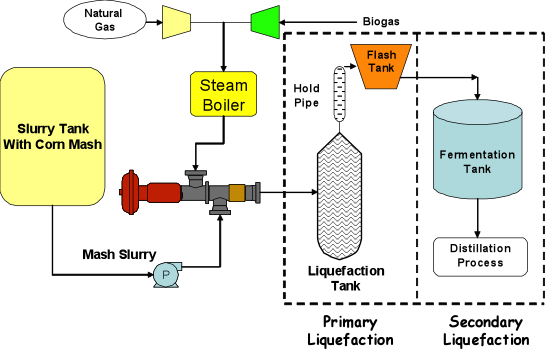
Application: PSX Jet Cooker - Ethanol Production - Starch Liquefaction
The Jet Cooker is a critical to evenly hydrolyze and heat the grain mash slurry. The relationship between the Jet Cooker’s steam injector and condensing tube produces a pressure drop to help maximize shear action to improve starch conversion. Ethanol (ethyl alcohol or grain alcohol) is produced through a liquefaction process whereby a starch is converted to a sugar, which is then converted to an alcohol product referred to as ethanol. Ethanol production requires a starch (corn, wheat, rye) based feedstock to supply the conversion process. The grain mash must go through a cook process, to raise the slurry’s temperature. In the Primary Liquefaction Stage, slurry is then pumped through a pressurized jet cooker at 221°F and held for 5 minutes. The mixture is then cooled by an atmospheric or vacuum flash condenser. After the flash condensation cooling, the mixture is held for 1–2 hours at 180–190°F to allow the enzymes time to work.- Poor alignment of the steam injector and condensing tube can causes artificially high delta P, pre-mature localized wear, non-uniform shearing action, and an increased use of enzymes to compensate.
- The poor alignment of steam injection and condensing tube leads to overdriving the condensing tube which can reduce starch slurry flowrates through the Jet Cooker and increases energy consumption by placing a higher demand on the slurry pumps.
- Single point condensing tube drive systems lead to premature failure of drive components.
PSX Jet Cooker Solution:
The PSX heater is state of the art Jet Cooking technology. The steam condensing tube has multiple bearing surfaces thus providing precise alignment with the steam injector which assures radial flow of starch slurry in the Jet Cooker. The unique drive system rotates the condensing tube thus eliminating localized wear.
ProSonix Direct Steam Injection Key Benefits:
- Multiple Bearing Surfaces assures proper alignment between the condensing tube and steam nozzle thus improved shear action and reduces enzyme consumption.
- Industrial Drive System eliminates single point drive failure points improving reliability
- Reduced pressure drop improves performance and reduces energy consumption
- Lower Maintenance Costs with improved drive system reduces internal wear
- Reduced Plant Air Consumption as drive system utilizes AC Motor.
